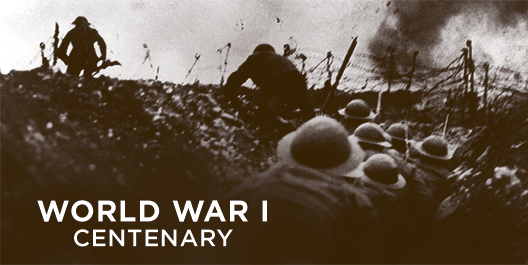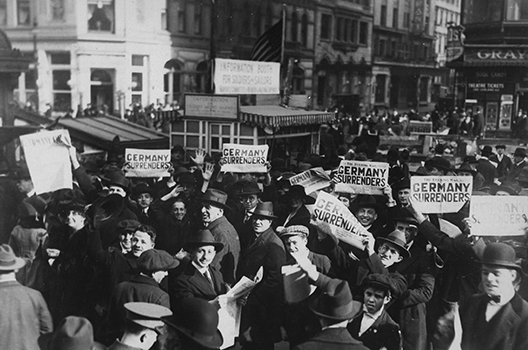One hundred years ago, at 11:00 a.m. on November 11, 1918, the guns fell silent on the western front. The end of World War I set into motion a new course for Europe, and remains an important facet of European politics. The bloody war that lasted more than four years stole a generation of mostly men from both sides. Here are eleven things to know about the Great War. 
-
- The shot that was heard around the world. On June 28, 1914, Archduke Franz Ferdinand, the heir to the Austro-Hungarian Empire, and his wife, Sophie, were shot dead by a nineteen-year-old Serbian nationalist, Gavrilo Princip, as they rode in a procession through the streets of Sarajevo. Austria-Hungary blamed the Serbian government for the assassination and sought military support from Germany’s Kaiser Wilhelm II in preparation for war. Serbia was backed by Russia. By the time the Austro-Hungarian Empire declared war on July 28, 1914, both sides had officially gained powerful allies.
- Many actors were involved. The Triple Entente (France, Russia, Britain) and the Triple Alliance (Germany, Austria-Hungary, Italy) both acquired additional forces following the outbreak of war. The Allies gained Belgium, Greece, Italy, Montenegro, Portugal, Romania, Serbia, and the United States. Italy’s allegiance to the Central Powers was inconsistent, but the Ottoman Empire and Bulgaria were added into the mix.
- The United States eventually joined the war. At the start of the war, US President Woodrow Wilson pledged neutrality—a position supported by a majority of Americans. On April 6, 1917, however, the United States, now galvanized for war by the “Zimmerman Telegram,” declared war on Germany after German U-boats sank US merchant ships.
- A deadly day. The heaviest loss of life in a single day occurred on July 1, 1916, when the British army suffered 57,470 casualties, including 19,240 fatalities, in the Battle of the Somme.
- One battle lasted 300 days. The Battle of Verdun lasted from February to December 1916. The Germans managed to surprise the French, and the heavy use of artillery accounted for 70 percent of the estimated 800,000 casualties. Nine French towns were completely destroyed, and while they were never rebuilt, still appear on maps to this day.
- Women fought, too. The Russian forces called upon women to join female shock battalions in order to boost morale in the later years of the war. June 1917 saw the 1st Women’s Battalion of Death marching out to the front. Though the practice was discontinued following a substantial loss in one unit, many women continued to apply and fight for the regular units.
- Explosions in Ypres were heard in London. British forces dug tunnels and laid approximately one million pounds worth of explosives underneath German lines outside Messines. British soldiers on the scene were reportedly knocked off their feet, and those in France mistook the vibrations for an earthquake. The Messines detonations are considered to be one of the largest human caused pre-nuclear era explosions.
- An elephant made an appearance. With a majority of horses being used on the front, Britain utilized the circus animals they had to cart around much-needed munitions. The most famous of these animals was Lizzie, an Indian elephant who wore boots as she carted around food and necessities in the town of Sheffield.
- Vengeance at Versailles. French Prime Minister Georges Clémenceau pointedly picked the Hall of Mirrors in Versailles for peace negotiations, as it was there the Germans had declared the German Empire. The Treaty of Versailles was signed on June 28, 1919. It came into effect on January 10, 1920. Germany was forced to accept full responsibility for the war, give up vast amounts of territory, and pay $31.4 billion in reparations. The result, as France wanted, crippled Germany. On October 3, 2010, Germany paid off the last of its debt set by the Treaty of Versailles. The global economic crisis in 1931 as well as Adolf Hitler’s rise to power had cut off its trend of paying annually.
- Nine new countries. Lithuania, Latvia, Finland, Poland, Austria, Hungary, Czechoslovakia, Yugoslavia, and Estonia were able to exist independently following the collapse of the Austria-Hungarian Empire. Two of these countries (Czechoslovakia and Yugoslavia) were brand new.
- Laying the foundations for the United Nations. At the end of the war, the League of Nations was created to “promote international cooperation and to achieve peace and security.” It disbanded following Hitler’s rise to power, but made way for the United Nations that now comprises 193 nations.
Inka Boehm is a communications intern at the Atlantic Council. Follow her on Twitter @inkaboehm.
Image: A crowd in Times Square hold up copies of newspapers with a headline about the signing of the Armistice to end World War One, in New York, U.S., November 11, 1918. U.S. (National Archives/via REUTERS)
